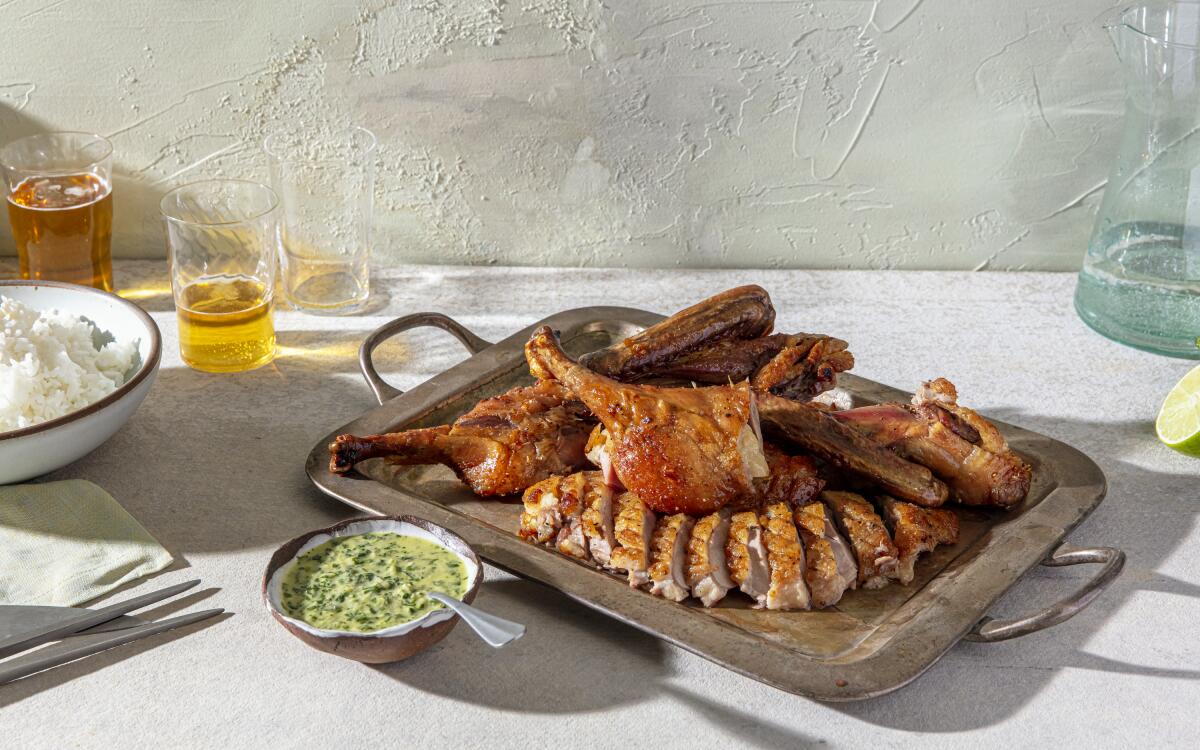Spatchcocked Roast Duck With Vietnamese-ish Herb Sauce

- Share via
When buying ducks, ask your butcher for Pekin or a Pekin hybrid like the Mulard. Most likely the ducks will be sold frozen, so prepare ahead and leave at least one day for it to thaw in the refrigerator. Save the giblets, neck, backbone and any trimmings to make duck stock, just as you would chicken stock. It makes a great base for soups, risotto or sauces. Similarly, save any trimmed duck fat and render it to use in roast potatoes.
Line a large rimmed baking sheet with a sheet of foil, then top with a wire rack. In a small bowl, stir together the salt, 1 1/2 teaspoons sugar and the black pepper and reserve.
Put the duck onto a large cutting board breast side down. Pat the inside and outside of the duck with paper towels until very dry. Use sharp kitchen shears to cut along both sides of the backbone and remove it; reserve to use for stock or discard. Use the kitchen shears to cut away the excess fat from around the duck’s neck and legs; reserve for another use or discard.
Open the duck up so that the breastplate is exposed. Run the tip of a sharp chef’s knife along the center of the breast bone several times to open it up without completely cutting through it; this will allow the duck to flatten more easily. Flip the duck over so it’s breast side up and its legs are completely flat on the cutting board. Put both of your hands on top of the breasts and press down firmly to further flatten the duck.
Prick the skin all over with a fork, being careful to not prick into the flesh. Use a paring knife to gently score the skin of both breasts in a crosshatch pattern, spacing the cuts every 1/4-inch. Be careful to not cut all the way through the skin into the flesh, which can happen easier than you think. Transfer the duck to the prepared baking sheet. Sprinkle the reserved salt mixture evenly on all sides of the duck, then use your hands to rub it in. Arrange the duck breast side up and completely flat on the rack. Tuck both wings behind the duck’s back.
Refrigerate the duck, uncovered, until the skin is completely dry to the touch and the skin around the legs and wings is mostly translucent, at least 48 hours and up to 72 hours total.
When you are ready to roast the duck, remove it from the refrigerator and allow it to sit at room temperature for 30 minutes. Position a rack in the center of the oven and heat to 375 degrees. Roast the duck, rotating the baking sheet once halfway through the cooking, until a thermometer inserted into the thickest part of one of the breasts reads 140 degrees (the thighs should have an internal temperature of 170 to 180 degrees), 45 to 55 minutes.
Remove the duck from the oven and increase the oven temperature to 475 degrees. Return the duck to the oven and roast, rotating the baking sheet once halfway through cooking, until the skin is deeply browned and crispy, 8 to 12 minutes. Transfer the baking sheet to a rack, tent the duck loosely with foil and let rest for 15 minutes.
While the duck rests, make the herb sauce: Combine the lime juice and remaining 2 teaspoons sugar in a small bowl and stir until the sugar has completely dissolved. Pour this into a blender along with the cilantro, mint, scallions, olive oil, fish sauce, garlic, ginger and jalapeño. Pulse until mostly smooth but still speckled with the green herbs, then taste and season with more fish sauce if you like.
Carve the duck and transfer to a serving platter. Serve with the herb sauce on the side and rice.
Get our Cooking newsletter
Get a taste of Los Angeles — and the world — with recipes and kitchen tricks from the L.A. Times’ Cooking newsletter.
You may occasionally receive promotional content from the Los Angeles Times.















